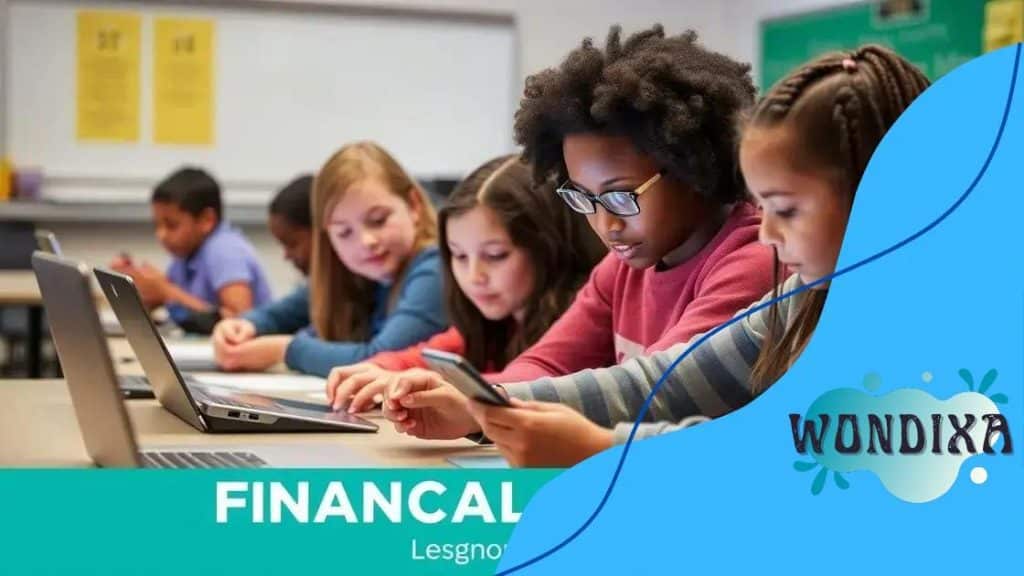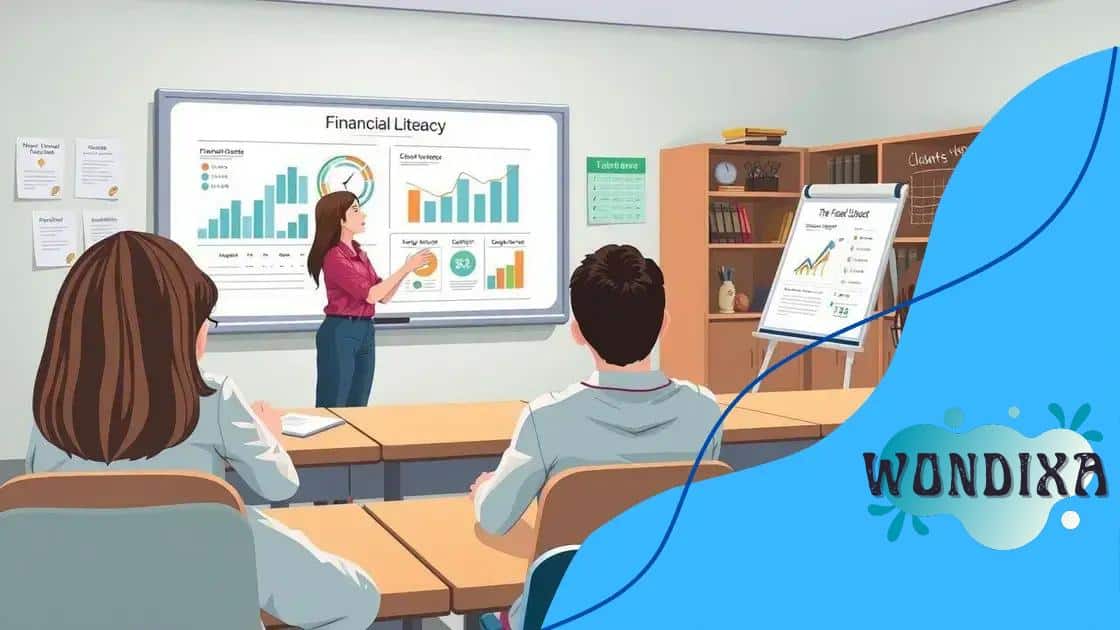Integrating financial literacy into digital curricula for success

Integrating financial literacy into digital curricula equips students with essential skills for managing personal finances, promoting responsible decision-making, and preparing them for financial challenges in adulthood.
Integrating financial literacy into digital curricula is more important than ever. Have you thought about how these skills impact students’ lives? In this article, we’ll explore why financial education in schools is essential.
Understanding financial literacy in education
Understanding financial literacy in education is crucial as it lays the foundation for students’ success in life. With many young people facing financial difficulties, teaching them essential skills can empower them to make informed decisions.
Importance of Financial Literacy
Financial literacy equips students with knowledge about managing money, budgeting, and making wise investments. Knowing how to save effectively can help them avoid common pitfalls. As they learn these skills, they become more confident in handling finances.
Key Concepts in Financial Literacy
Some key concepts include:
- Budgeting: Understanding how to plan spending and save for future needs.
- Saving: Learning the importance of setting aside money for emergencies and goals.
- Investing: Gaining knowledge on how to grow their wealth over time.
- Credit management: Understanding credit scores and how to use credit responsibly.
These topics are often overlooked in traditional schooling, yet they can significantly affect a person’s financial stability. By incorporating these lessons into the curriculum, schools can prepare students for real-world financial challenges.
Teachers can use various tools to make financial literacy engaging. Interactive lessons, games, and practical examples help students grasp these essential concepts more effectively. When lessons are relatable, students are more likely to retain information.
Furthermore, involving parents in financial education can amplify its impact. Parents who discuss financial topics at home reinforce what students learn in class. This collaboration between home and school enhances understanding and retention.
Key benefits of integrating financial literacy
Key benefits of integrating financial literacy into education are numerous and impactful. Students gain essential skills that last a lifetime. Learning about money management, budgeting, and saving helps them navigate financial decisions confidently.
Empowerment Through Knowledge
One of the main benefits is empowerment. When students understand how to manage their finances, they feel more in control. They learn to set goals and make informed choices. This knowledge lays the foundation for a responsible financial future.
Improved Decision-Making
Another critical benefit is improved decision-making. Students who learn about financial concepts can analyze their spending habits. They become aware of the long-term effects of their choices, which can help them avoid debt.
- Understanding the importance of savings leads to better financial stability.
- Learning about credit helps students manage debt effectively.
- Knowledge of investments opens the door to future wealth building.
Furthermore, integrating financial literacy into the curriculum fosters discussions about money at home. Parents can engage with their children on these important topics. This collaboration enhances learning and reinforces positive habits.
Schools that prioritize financial literacy also see happier and more responsible students. With a solid understanding of finances, students are less likely to experience stress related to money. They can focus on their studies and personal growth.
Challenges in teaching financial literacy

Challenges in teaching financial literacy can significantly affect how effectively these important skills are imparted to students. Various factors contribute to the difficulties educators face in delivering robust financial education.
Lack of Resources
One major challenge is the lack of resources available for educators. Many schools do not have textbooks or materials focused on financial topics. This limitation makes it hard for teachers to deliver comprehensive lessons. Without the right tools, teaching can become less engaging and informative.
Teacher Preparedness
Another challenge is the preparedness of teachers. Many educators may not feel confident teaching financial literacy due to their own lack of knowledge or training in this area. This can lead to ineffective teaching methods and missed learning opportunities for students.
- Limited professional development in financial topics.
- Inexperience with financial concepts can hinder effective instruction.
- Teachers may prioritize other subjects perceived as more critical.
On top of this, parents and guardians often play a role in students’ financial education. If families lack financial knowledge themselves, they may not reinforce what students learn at school. This disconnection can create gaps in understanding and application of financial concepts.
Moreover, students may find financial topics dull or irrelevant. Captivating their interest can be challenging. Teachers must employ more interactive and engaging methods to make financial literacy appealing.
Innovative strategies for curriculum development
Innovative strategies for curriculum development in financial literacy are essential for engaging students and fostering real-world skills. Creating a dynamic learning environment encourages students to grasp financial concepts more effectively.
Project-Based Learning
One effective strategy is project-based learning. This approach allows students to tackle real-world problems, such as budgeting for a school event or planning a mock investment portfolio. Through hands-on activities, students can better understand financial principles.
Integrating Technology
Another vital strategy is integrating technology into the curriculum. Using apps and online platforms, teachers can make financial concepts interactive. For example, simulation games can help students learn about trading stocks and making financial decisions in a risk-free environment.
- Online resources provide access to up-to-date financial information.
- Interactive tools can engage students in learning exercises.
- Gamification can enhance motivation and participation.
Teachers can also invite guest speakers from the finance industry. This exposure provides students with insights into careers in finance and the importance of financial literacy in various professions. Real-life experiences can inspire students and deepen their understanding of the subject.
Furthermore, promoting collaboration among students can enhance learning. Group projects allow students to share ideas and learn from each other. By discussing diverse viewpoints, they develop a broader understanding of financial topics.
Measuring the impact of financial literacy
Measuring the impact of financial literacy is crucial to understand how effectively these skills are being taught and learned. Evaluating the outcomes helps identify areas for improvement and reinforces the importance of financial education.
Assessing Knowledge Gains
One effective method for measuring impact is through assessments. Pre and post-tests can show students’ knowledge gains after completing a financial literacy program. These tests provide insights into what students have learned and areas they still need to focus on.
Behavioral Changes
Another critical aspect is to observe behavioral changes. Financial literacy programs aim to influence how students manage money. Surveys can assess changes in behaviors like budgeting, saving, and spending. Collecting data through surveys allows educators to track improvements in financial practices over time.
- Tracking savings rates among students.
- Monitoring the use of budgeting tools.
- Observing student engagement in financial decisions.
Additionally, educators can analyze case studies of students who have participated in financial literacy programs. Real-life examples can highlight success stories and demonstrate the long-term benefits of financial education. Case studies allow for a deeper understanding of how learned skills apply outside the classroom.
Partnerships with financial institutions can also be beneficial. These organizations often have resources and data to help assess the overall impact of financial literacy initiatives. Collaborating with them can provide additional insights and support for measuring outcomes.
In conclusion, integrating financial literacy into educational programs is essential for preparing students for their future. By teaching these vital skills, we empower students to make informed financial decisions. Measuring the impact of financial literacy helps educators refine their approaches and maximize effectiveness. Through innovative strategies, we can engage students fully and ensure they develop a solid foundation in managing their finances. This investment in education is crucial for fostering responsible citizens who can navigate the complexities of the financial world.
FAQ – Frequently Asked Questions about Financial Literacy Education
What is financial literacy?
Financial literacy refers to the knowledge and skills needed to make informed financial decisions, including budgeting, saving, and investing.
Why is financial literacy important for students?
Financial literacy equips students with essential skills to manage their personal finances effectively, helping them avoid debt and achieve their financial goals.
How can financial literacy be taught in schools?
Financial literacy can be taught through interactive lessons, project-based learning, and incorporating technology to engage students in real-world financial scenarios.
What are some common challenges in teaching financial literacy?
Common challenges include a lack of resources, teacher preparedness, and students’ disinterest in financial topics, which can make teaching these skills difficult.





